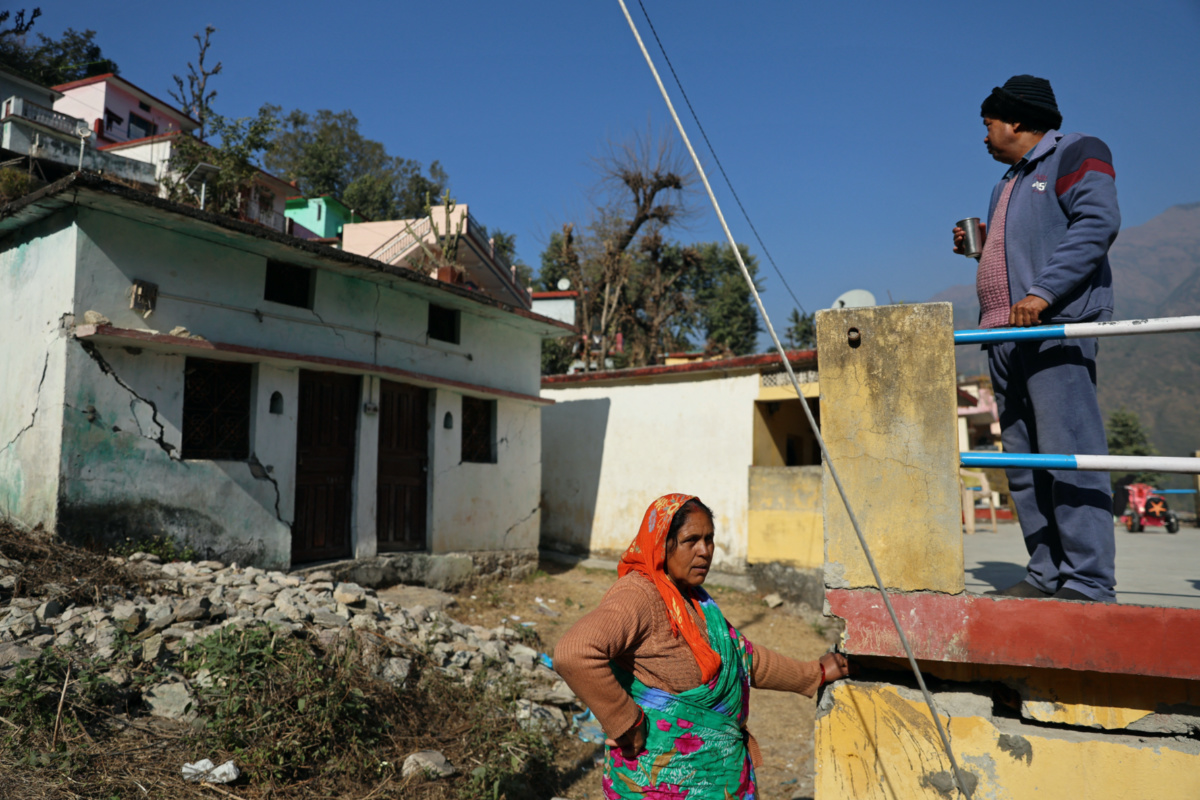
KRISHN KAUSHIK reports for Reuters, on concerns about the impact large construction projects are having on buildings in India’s northern Himalayan state of Uttarakhand…
Joshimath, India
Reuters
One morning 18 months ago, Jaswant Singh Butola woke to find hairline cracks had spread up the walls of his house, which overlooks a railway being built to take pilgrims to Himalayan holy sites in India near the border with China.
Since then the cracks have widened. A pillar hangs loosely from a wall and Butola, 55, fears he will soon have to abandon Maroda, the village his family has called home for generations.
“It is an old village, our ancestral village,” he said, gazing at earthworks for the railway from his lopsided house, itself surrounded by other shattered homes. “This is absolute destruction.”

Jaswant Singh Butola (right), 55, looks at houses which have been vacated due to damage that he says developed after infrastructure works began close to the village, while standing next to his neighbour Munni Devi, 55, in Maroda, in the northern state of Uttarakhand, India, on 17th January, 2023. PICTURE: Reuters/Anushree Fadnavis
Indian Prime Minister Narendra Modi’s push to carve roads and rail deep into the Himalayan mountains is smoothing the way for millions of Hindu and Sikh pilgrims to visit a clutch of religious sites that include the source of the Ganges river.
Developing the area is part of the Modi government’s stated strategy of reaffirming India’s presence along the largely undemarcated border with China, parts of which are contested and have seen military skirmishes in recent years. China has its own infrastructure drive on the neighbouring Tibetan plateau.
“It is an old village, our ancestral village. This is absolute destruction.”
– Jaswant Singh Butola, who lives in the vllage of Maroda.
“Modern connectivity is also a guarantee of national security,” Modi said at an election rally at a border village in October, where he said the new transport links would bring development to remote regions. “The border areas of the country are being connected with the best and the widest highways.”
The strategy has run into trouble, however, with some works halted by local authorities in the face of protests by residents after hundreds of houses were damaged by subsidence along the routes, in India’s northern Himalayan state of Uttarakhand.
The buildings and the land beneath houses had been weakened – geologists, residents and officials say – by the rapid construction in the geologically unstable mountains.
The office of Uttarakhand’s chief minister and the spokesperson for the federal government did not respond to requests for comment for this story. India’s ministries of highways and railway, which own the state-run companies building the road and rail projects, also did not respond.
On a reporting trip in January, Reuters found damage in Maroda and five other towns and villages close to either the $US2 billion railway or a connected $US1.5 billion highway project, both named after the Char Dham pilgrimage route. While the news agency was unable to find definitive proof connecting all the problems to individual infrastructure works, in two of the towns authorities made a link between subsidence and the projects.
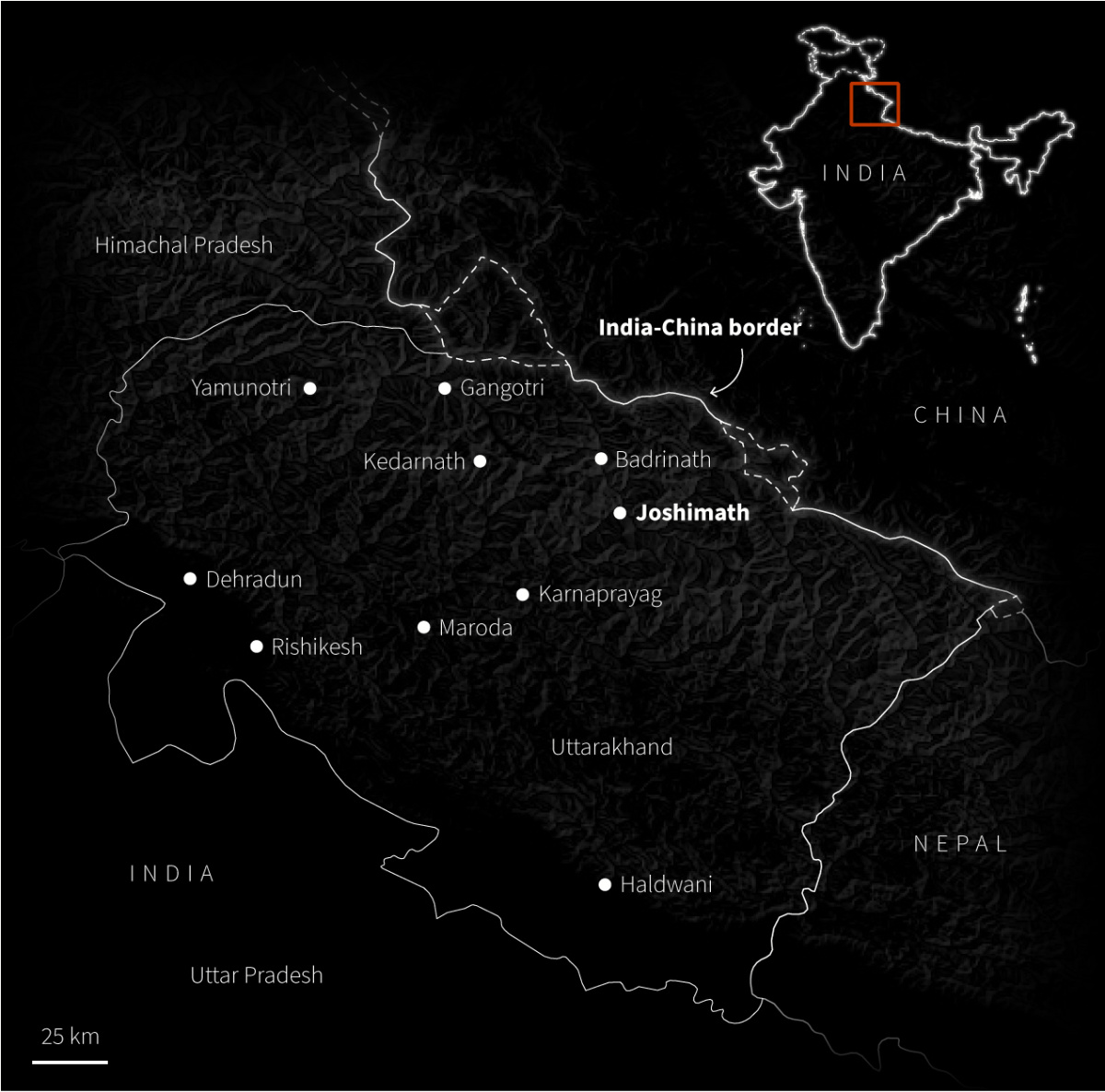
GRAPHIC: Reuters
In Maroda, the district magistrate said in a written communications with residents, reviewed by Reuters, that the railway ministry’s construction company, RVNL, would compensate villagers by buying additional land affected by subsidence.
RVNL did not respond to a request for comment for this story.
Nine residents from three villages along the 125 kilometre rail route stretching from Rishikesh to Karnaprayag, showed Reuters damage to their homes they said started appearing soon after blasting or other work for 104 kilometres of tunnels began near their villages.
“There is a direct connection,” environmentalist Ravi Chopra said about the link between the projects and subsidence.
“When the explosions take place, whether it is for tunneling or it is for blasting rocks, the mountains shake and very often new fissures are introduced,” said Chopra, who has studied the region extensively and headed a Supreme Court appointed panel assessing the Char Dham highway.
Piyoosh Rautela, an executive director with Uttarakhand’s disaster management authority, told Reuters poorly planned residential construction was responsible for subsidence in towns where populations are growing fast to accommodate the influx of pilgrims in previously inaccessible areas.
Maroda, however, had barely grown or changed in decades until the railway engineers approached the cluster of houses in 2021, and started slicing through rock with heavy machinery to prepare for tunneling, nine residents told Reuters.
Eight of the families neighbouring Butola have now left the village, their homes riven with cracks, villagers told Reuters.
“The whole night the work goes on below on the railway line and the cement from the house keeps falling down. We live in a lot of risk,” said village resident Munni Devi.
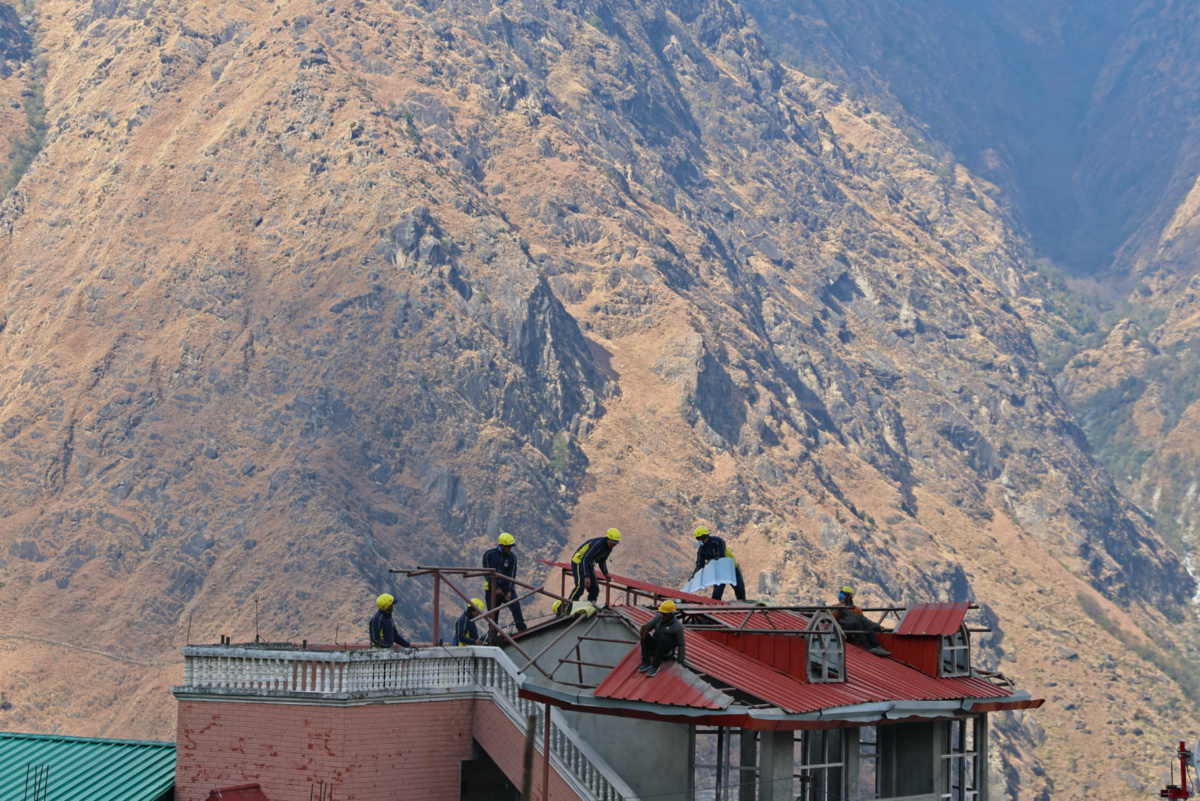
Workers for the National Disaster Response Force demolish a hotel after cracks developed on the property, in Joshimath, in the northern state of Uttarakhand, India, on 13th January, 2023. PICTURE: Reuters/Anushree Fadnavis
When Reuters visited on 17th January, a railway employee measuring the depth of subsidence on the outskirts of the hamlet said the land appeared not to have sunk further in recent weeks.
A notice posted in November at the village authority’s office states that RVNL was purchasing an additional 1,387 hectares of land from villagers because of subsidence, at a cost of almost 300 million Indian rupees ($US3.6 million).
The costs were worthwhile, the notice signed by the district’s highest-ranking official said, because “with the development of the rail line it will become easier to reach the border areas, and from the perspective of tourism it will also make the Char Dham pilgrimage more comfortable.”
Butola said RVNL officials had told him verbally his home would be included in the purchase, but he had yet to receive written notification or payment.
More than 80 kilometres of tunnels have been completed, the federal railway ministry said on 7th January. Work is ongoing and scheduled to be completed next year.
We rely on our readers to fund Sight's work - become a financial supporter today!
For more information, head to our Subscriber's page.
The situation in Uttarakhand garnered national attention in January after cracks developed in more than 800 homes in the town of Joshimath, further into the mountains from Maroda and 100 kilometres from the border with China.
Some houses crumbled completely, forcing hundreds of occupants to evacuate. Officials halted road construction work near the town, fearful of a bigger collapse.
For some residents, blame for the subsidence lies with a large hydropower project being built by state utility NTPC a few kilometres away from Joshimath.
Officials and experts mostly disagree with this assessment, but like other construction projects in the area the hydro power project has run into difficulties with the glacial Himalayan geography. A tunnel borer is trapped underground and NTPC has been trying to free it for more than a decade, the company said in a written response to Reuters.
Work was halted, including controlled explosions at a distance of about 10 kilometres from the town, once the scale of the damage in Joshimath became clear, NTPC said. The company said its work had nothing to do with the subsidence, however, as the tunnel work under the town was finished over a decade ago, and used the less disruptive boring machine, instead of explosives.
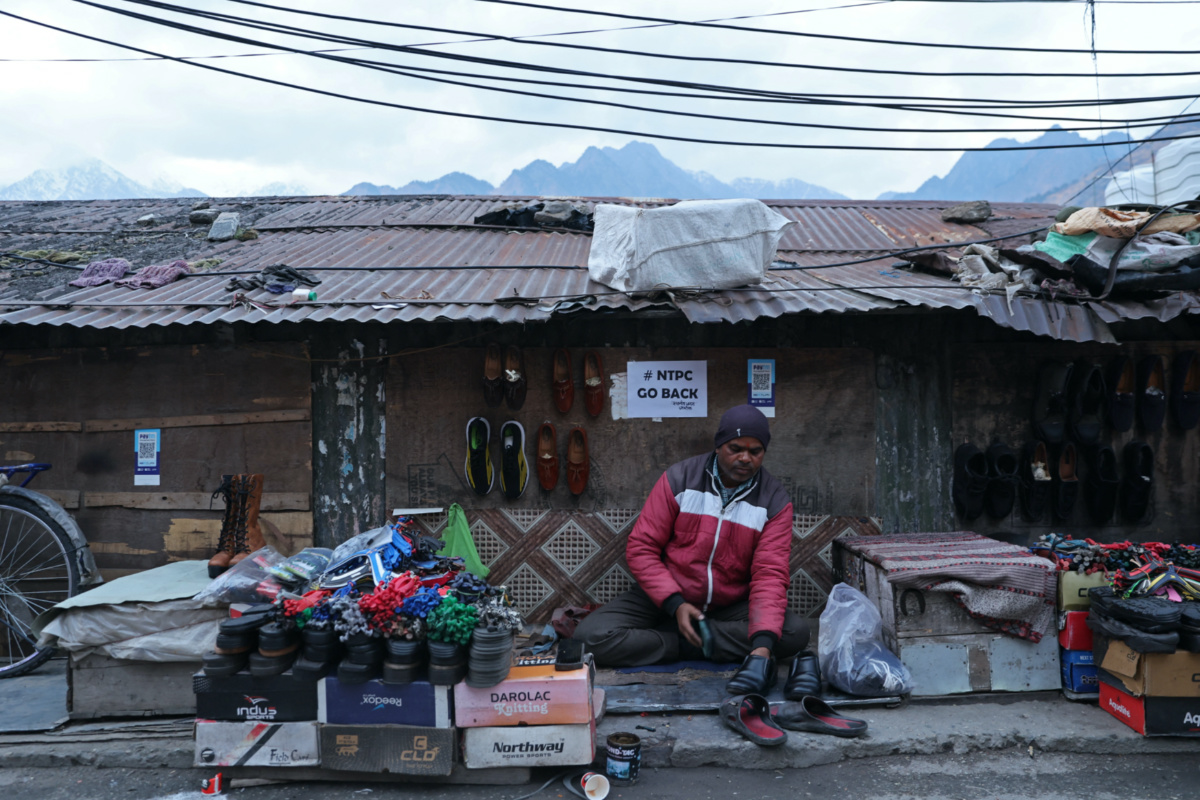
A man works at a makeshift street shop in front of a placard, directed at the government’s largest power producer, NTPC, which reads “NTPC Go Back”, which had been put up by the local residents, in Joshimath, in the northern state of Uttarakhand, India, on 14th January, 2023. PICTURE: Reuters/Anushree Fadnavis
The land subsidence brought back memories of devastating flooding in the region ten years ago believed to have killed thousands of pilgrims and partly blamed on haphazard construction.
Despite the dangers, and encouraged by Modi’s own frequent visits and promotion of the infrastructure works, the number of people visiting the four Hindu holy sites in the area has soared since, almost doubling to more than 4 million in 2022 from three years earlier, according to data from Uttarakhand’s tourism ministry cited in Indian media.
An important stopover for travellers, Joshimath itself has more than doubled in size to nearly 4,000 hotels, homes and other commercial buildings over the past decade, two municipal officials said.
The town’s population has increased by almost half to nearly 25,000 in the same period, they said.
We rely on our readers to fund Sight's work - become a financial supporter today!
For more information, head to our Subscriber's page.
An October report from an expert committee constituted by state authorities last year flagged unregulated construction as a risk to the stability of the town.
The report, a copy of which was reviewed by Reuters, also noted improper drainage resulted in rainwater and waste water seepage that caused cavities in the mountainside beneath Joshimath.
Additionally, the impact of the nearly 900-kilometre Char Dham highway project on Joshimath and other areas it passes near were not properly assessed before construction started, a report by the Supreme Court-appointed committee headed by environmentalist Chopra said in July 2020.
According to the committee, the majority of whose members were government officials, a decision by the federal government to divide the project into short sections circumvented a rule that mandates stricter environmental assessments for roads longer than 100 km (62 miles).
The highways ministry and a spokesperson for the federal government did not respond when asked if the decision to divide the project was taken to avoid assessments. In 2019, the highways ministry told parliament the design of the project as a series of district roads meant mandatory impact studies were not required.
Mountainsides were cut away “without adequate prior site studies” leading to landslides, subsidence and collateral damage to ecology and social infrastructure, the report said.
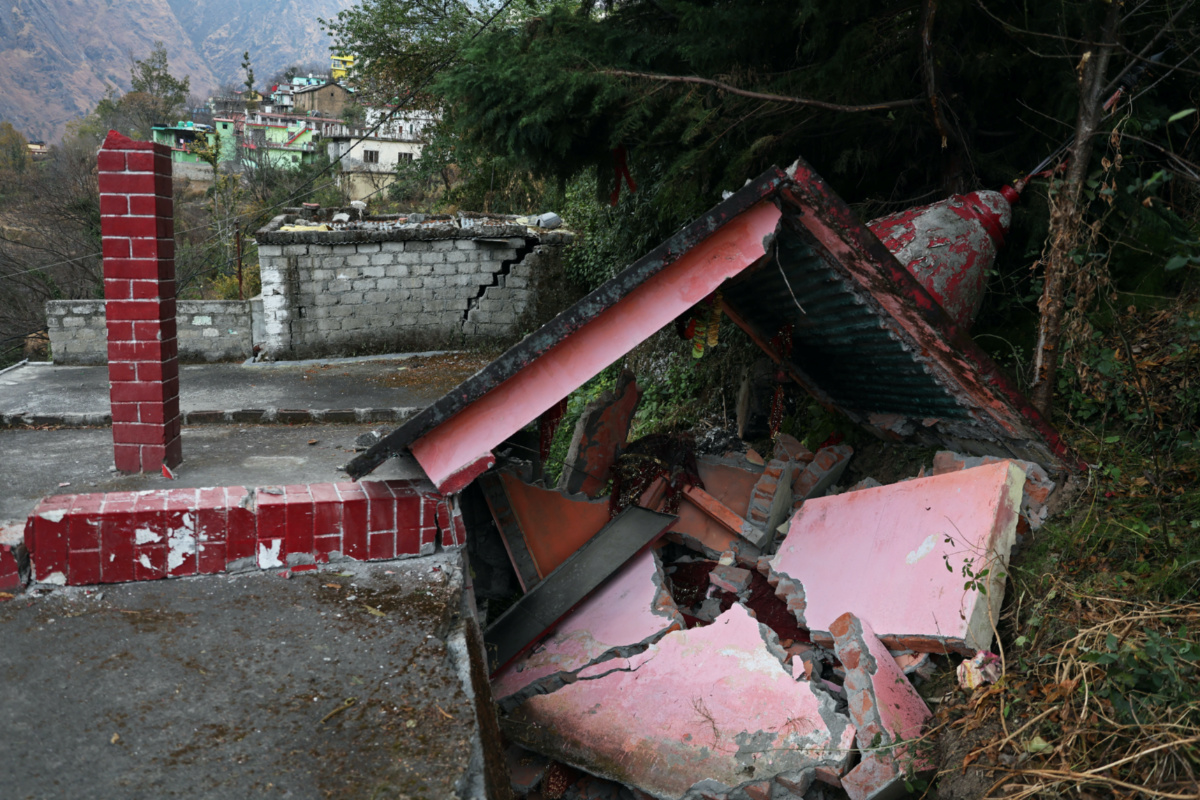
Damaged walls crumble at a temple near a house in the Singdhar area of Joshimath, in the northern state of Uttarakhand, India, on 13th January, 2023. PICTURE: Reuters/Anushree Fadnavis
Cracks big enough for a fist to pass through began appearing two years ago in the house of Mukesh Khanduri, 37, in the town of Karnaprayag. District authorities said the road-widening was to blame and recommended the highway ministry’s construction arm pay compensation and move him from the unsafe house. Khanduri is now waiting to be relocated.
“People won’t exist here anymore. Only the roads will,” he said.
When it approved the Char Dham road in 2021, the Supreme Court said wider roads would be beneficial to defend India’s borders. It cautioned, however, that the government should heed concerns raised by the committee, and draw up a concrete strategy to protect the environment.
Chopra said that had not happened. He quit the committee last year frustrated that recommendations were not implemented.
“It just seems like a mad rush to build,” he said.
The federal government has publicly said it employed environmentally friendly techniques in the design of the Char Dham projects to make geologically unstable stretches safer.
– Additional reporting by DEVJYOT GHOSHAL, SAURABH SHARMA and SARITA CHAGANTI SINGH






